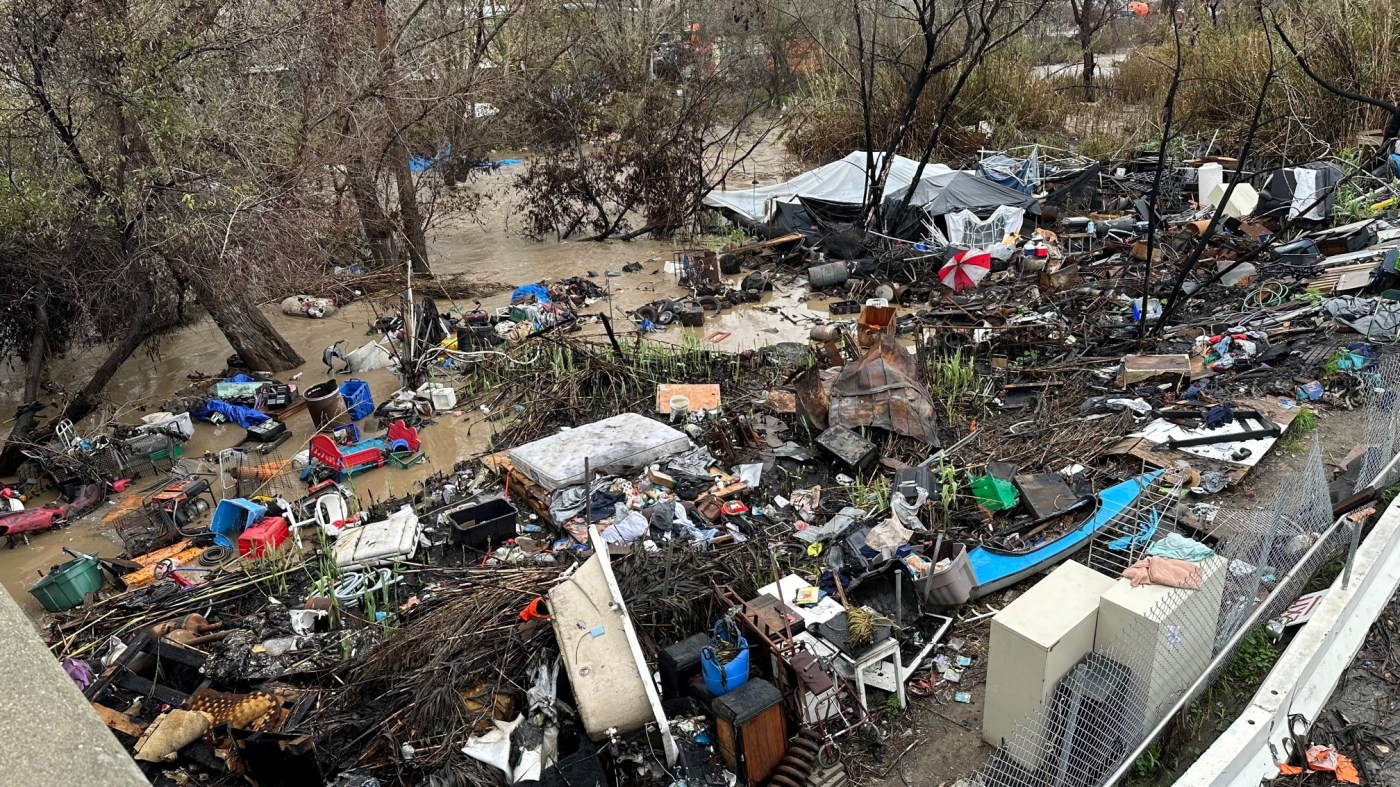Unable to come to agreement over what do to about widespread pollution and threats to their employees while still treating homeless people fairly, the board of Silicon Valley’s largest water agency on Tuesday delayed a vote on a new ordinance to ban camping along 295 miles of creeks in San Jose and other parts of Santa Clara County.
After four hours of public testimony, the Santa Clara Valley Water District’s seven-member board chose to send the issue back to one of its committees to be revised, with a possible return for a vote later in the fall.
“It’s not how you start, it’s how you finish,” said board member Dick Santos.
The district, a government agency based in San Jose, has spent $3.4 million since July removing 15,050 cubic yards of debris — enough to fill 1,500 dump trucks — from Coyote Creek, Guadalupe River, Los Gatos Creek and other South Bay waterways.
Water district staff members say a growing number of encampments are polluting the South Bay’s creeks with hazardous materials, piles of trash, batteries, propane tanks and human waste. People in the encampments have trapped endangered steelhead trout with shopping carts, cut down trees, started wildfires that threatened nearby homes, discarded needles and built makeshift structures in areas prone to winter flooding.
The water district’s staff members also report being increasingly threatened when they travel to the creeks to take water quality samples, conduct flood control work and perform other tasks.
“People have brandished knives, machetes and guns at them,” said Jennifer Codianne, the district’s deputy for watershed operations and maintenance. “It’s not safe for our staff to provide flood protection work.”
The district estimates that roughly 700 people live along the creeks it oversees. Its proposed ordinance would have banned encampments along those creeks, and fouling the waterways with “trash, debris and hazardous pollutants,” shooting off explosives or fireworks, or harassing district workers.
After being given a verbal and written warning providing 72 hours to remove an encampment, violators would have been subject to fines of up to $500 and 30 days in jail. The new law would have been enforced by local police and sheriff’s deputies.
The debate over it brought out passionate testimony from dozens of people Tuesday. Some residents who live near creeks said the measure was long overdue.
Yamini Sadasivam, a San Jose resident of San Jose who lives near Los Gatos creek in the Willow Glen neighborhood, told the board she was confronted by a homeless man with a large bow-and-arrow when she was outside her home.
“This terrifying experience left me feeling extremely unsafe in my own neighborhood,” she said.
“Seven fires have been reported near our neighborhood, putting our lives and homes at risk,” she said, adding that open air drug dealing, car break-ins, and other problems have come from people living in the creek nearby. “This is unacceptable. This constant threat is not something any community should have to endure.”
Others said the proposed rules were unfair and counterproductive.
“We can address these problems without criminalizing people for trying to survive,” said Jan Bernstein Chargin, board chair of PitStop Outreach, a Gilroy non-profit group that delivers meals to homeless people. “It will make people’s lives worse, clog up the courts and make it harder for them to get housed.”
Board members debated how much of a role the water district, whose primary mission is to provide drinking water and flood control to 2 million people in Santa Clara Valley, has to provide housing.
“We’re not a housing agency,” said Tony Estremera, a longtime water district board member. “We don’t build houses, which is the real solution. We can’t remove people because we don’t have police powers.
“We’re going to protect our employees,” he added. “I’ll tell you that right now. We are devoted to that.”
But board member Jim Beall, a former state senator, said the water district should do more to provide housing.
“We’re not the housing agency but we work with people who can provide housing,” he said. “We can provide land, and we can provide assistance.”
Last month, the San Jose City Council approved a plan to move about 500 homeless people living along creeks to sanctioned encampment sites on public property across the city. Of the eight locations chosen, five are owned by the water district. Each are 1 to 2 acres. They are along Lelong Street, Willow Street, at 14020 Almaden Road, 3278 Almaden Road, and Almaden Road at Canoas Garden Avenue.
Some have suggested those sites will hold tents for 100 or more people with supervision. Details have yet to be worked out between the city and the water district, however.
Helen Hutchings, a Willow Glen resident, said the any such sites should be built on county land, away from neighborhoods.
“We don’t feel it’s appropriate to house people in tent camps in anybody’s neighborhood when the county has so much land that could be used,” she said.
A coalition of eight environmental groups, including the Sierra Club Loma Prieta Chapter, Santa Clara Valley Audubon Society, California Native Plant Society and Green Foothills, supported the rules.
“We encounter feces, needles, even fires when we are out there during creek cleanups, along with weapons and dogs,” said Deb Kramer, executive director of Keep Coyote Creek Beautiful.
Several speakers said they had been or are currently are homeless.
“It is inhumane to fine people and put them in jail,” said James Campbell, who said he lives in his car in San Jose. “I have a car that is broken down. I am ticketed, the police are harassing me.”
Board member John Varela said the issue should be put off until after Oct. 11, when the water district is planning to hold a meeting with other agencies and the public to discuss solutions.
Rebecca Eisenberg was the water district board member most opposed to the ordinance.
“There’s no place for the unhoused to go when they are let out of jail,” she said. “It is not only arrogant, but irrational of us to say we know more than the unhoused who are here speaking before us now. We also know that the unhoused are not the biggest polluters to the streams. We cause more damage to the ecosystem than the unhoused do through our terribly, environmentally irresponsible projects that we build using massive amounts of cement and concrete.”












